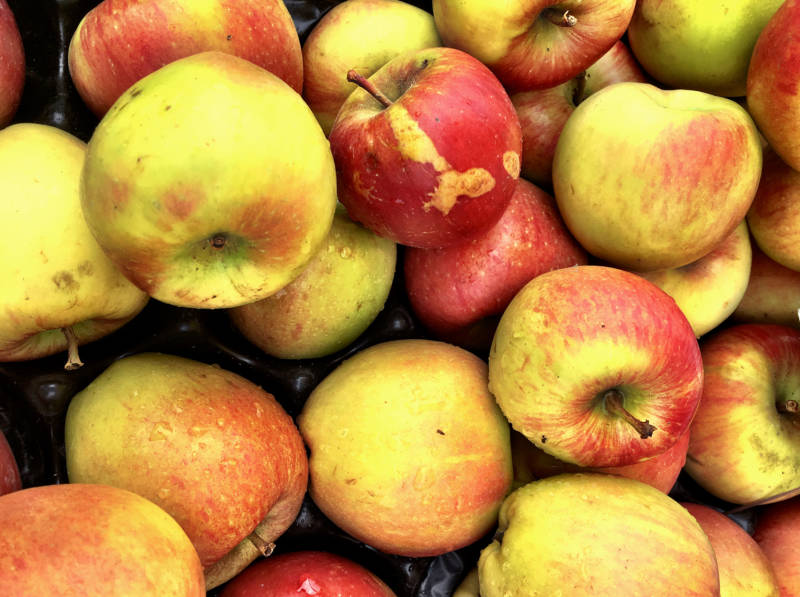We already suspect this is the case with organic fruits and vegetables. A 2014 review of 343 studies found that organic produce had lower pesticide residue and a 20 to 40 percent higher antioxidant content than conventional produce. Those antioxidants include compounds such as flavonoids, phenolic acids, anthocyanins and carotenoids, all produced by plants as defense mechanisms when they are stressed by pests. The study authors suggested that organic crops may be subject to more stress because they may receive fewer pesticides, in lower doses, and with less potent killing effects.
Another study of both conventional and organic apple varieties found higher antioxidant phenols and fruit acids in organic apples. The study authors noted, "The regular consumption of fruit acids is helpful in preventing illness and metabolic disorders. We recommend the consumption of regional organically grown varieties rather than of cultivars from integrated cultivation."
Ugly fruits actually bear the visible scars of their successful battles — dimpled or scarred where they fought off a biting or gnawing insect or surface infection. Greenman's ideal is a truly wild apple, one left to its own defenses in nature — with the cosmetic imperfections to prove it. Though not all pests and diseases are benign, she notes, a few common apple infestations are the result of harmless fungi that result in sooty "blotch" (dark patches) and fly speck (black dots), but do not harm taste or texture nor infect humans. These blotches are a result of the plant fighting off environmental insults — relying on its antioxidant defenses to do so. Greenman suspects those unsightly scars may reflect higher nutrition.
She may be right. One study showed that an apple covered in scab has more healthy, antioxidant phenolic compounds, called phenylpropanoids, than a scab-free apple peel. Another study showed that apple leaves infected with scab have 10 to 20 percent more phenolic compounds. Similar research has found high levels of resveratrol in grape leaves infected with fungi or simply exposed to the stress of ultraviolet light. A study of Japanese knotweed, a plant with a long tradition of use in Chinese and Japanese herbal medicine, found that infection with common fungi boosted its resveratrol content as well. Resveratrol is an antioxidant that's been well-studied for its potential cardio-protective action. All these antioxidants protect both plants, and probably the humans who eat them.
This does not mean that we should turn away from conventional agriculture, or make hard and fast assumptions about crops, says environmental biologist Brian Ward, of Clemson University in Columbia, S.C. "There are so many factors contributing to antioxidant content," says Ward, who oversees research in both conventional and organic agriculture. "The most important factor is the plant itself — and the variety. That's genetic. Then there is the soil, its mineral content, and whether conventional or organic fertilizer is used. But yes, there is some interesting data that when plants are stressed by insects or disease, they produce metabolites that are good for us."
Greenman's insight intrigues microbiologist Martin L. Pall, professor emeritus at Washington State University. Pall says that our own innate, potent protective mechanisms can be activated by compounds in fruits and vegetables. In fact, he suggests in a recent research paper, those antioxidants may serve as mild stressors that kick our repair mechanisms into high gear. They activate a molecule in our cells known as Nrf2, which itself can trigger the activity of over 500 genes, most of which have cell-protective functions.
"This is certainly true of compounds like resveratrol," he says. "That part of the story is pretty clear." He says there's intriguing evidence that other plant compounds that increase under stress may be good for our health, too, but those benefits are not as well-documented.
Pall contends that we have co-evolved for eons with plants whose compounds benefit us. He points out that known longevity diets — such as the traditional Mediterranean and Okinawan cuisine — are rich in exactly these compounds and antioxidants.
So, backyard organic gardeners, rejoice: Your imperfect produce may be more perfect than you thought. Next time you hesitate over a flawed fruit, remember that it may be a hardy survivor bearing hidden nutritive gifts.
Jill Neimark is an Atlanta-based writer whose work has been featured in Discover, Scientific American, Science, Nautilus, Aeon, Psychology Today and The New York Times.
Copyright 2016 NPR.
